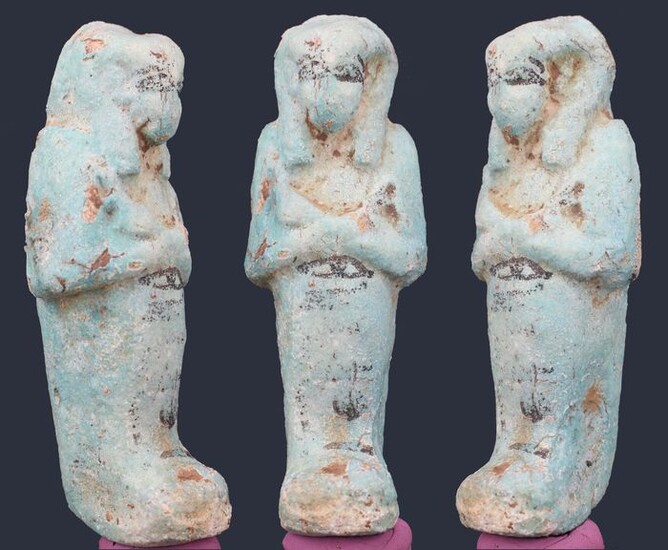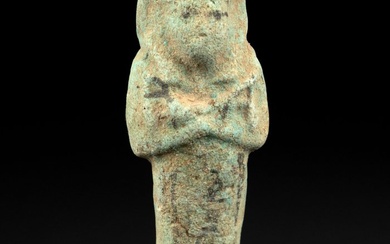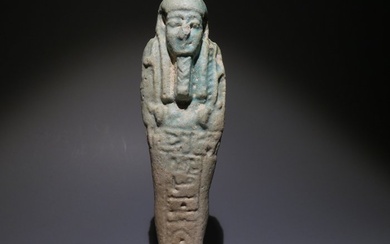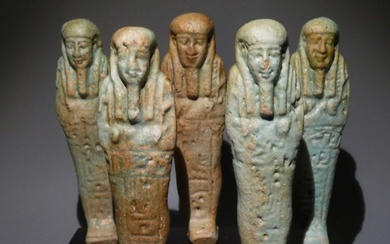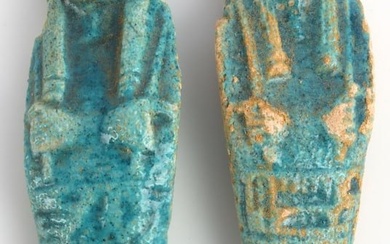Ancient Egyptian Faience Shabti of Nesi Khonsu 12 cm.
Inscription: "The Osiris, Nesi-Khonsu, justified" This ushabti figurine is depicted as a worker holding two hoes for work in the fields of Osiris in the afterlife. He is wearing a tripartite wig, which falls down between the shoulders. Only the hands, crossed over the chest and holding the already-mentioned agricultural implements, emerge from the mummiform shroud covering the entire body. The material used for the creation of this ushabti is faience, composed of fine sand cemented with sodium carbonate and sodium bicarbonate extracted from natron. Fired at c. 940 C°, the mixture gives an enamel-like finish with the carbonates forming a vitreous surface. It´s a simple procedure and therefore not costly. The red tones were achieved with iron oxide, the intense blues with cobalt, the black by mixing iron oxide and magnesium oxide with water. Green and blue tones were achieved by the addition of a grams of copper oxide extracted from malachite or azurite. Provenance: Previous ownership history: Private collection Austria U. Wallner, then S. D'alessandro, Italy, collected before 1980. I have acquired this object in 2010 in Italy from Eleonora Cavallaro. Important information. The seller guarantees that he is entitled to ship this lot. The seller will take care that any necessary permits will be arranged. The authenticity of the item is unconditionally guaranteed. Shipped by DHL The seller guarantees that he acquired this piece in a legal manner. Documentation proving this provenance has been seen by Catawiki.
[ translate ]View it on
Sale price
Estimate
Time, Location
Auction House
Inscription: "The Osiris, Nesi-Khonsu, justified" This ushabti figurine is depicted as a worker holding two hoes for work in the fields of Osiris in the afterlife. He is wearing a tripartite wig, which falls down between the shoulders. Only the hands, crossed over the chest and holding the already-mentioned agricultural implements, emerge from the mummiform shroud covering the entire body. The material used for the creation of this ushabti is faience, composed of fine sand cemented with sodium carbonate and sodium bicarbonate extracted from natron. Fired at c. 940 C°, the mixture gives an enamel-like finish with the carbonates forming a vitreous surface. It´s a simple procedure and therefore not costly. The red tones were achieved with iron oxide, the intense blues with cobalt, the black by mixing iron oxide and magnesium oxide with water. Green and blue tones were achieved by the addition of a grams of copper oxide extracted from malachite or azurite. Provenance: Previous ownership history: Private collection Austria U. Wallner, then S. D'alessandro, Italy, collected before 1980. I have acquired this object in 2010 in Italy from Eleonora Cavallaro. Important information. The seller guarantees that he is entitled to ship this lot. The seller will take care that any necessary permits will be arranged. The authenticity of the item is unconditionally guaranteed. Shipped by DHL The seller guarantees that he acquired this piece in a legal manner. Documentation proving this provenance has been seen by Catawiki.
[ translate ]